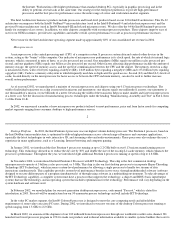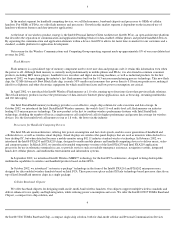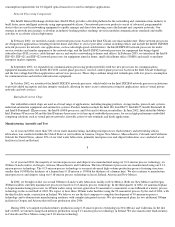Intel 2002 Annual Report Download - page 13
Download and view the complete annual report
Please find page 13 of the 2002 Intel annual report below. You can navigate through the pages in the report by either clicking on the pages listed below, or by using the keyword search tool below to find specific information within the annual report.
and develop and launch new products to meet them, and at the same time reduce our costs. Our competitors also routinely add features to their
products, seek to increase their products' performance and/or sell their products at lower prices over time. We cannot predict whether our
products will continue to compete successfully with existing rival architectures and/or whether new architectures will establish or gain market
acceptance or increase competition with our products.
In the semiconductor industry, prices decline rapidly as unit volumes grow, further competition develops and production experience is
accumulated. The life cycle of our products is very short, often less than a year. Many companies compete with us in the various computing,
networking and communications market segments, and are engaged in the same basic fields of activity, including research and development.
Worldwide, these
11
competitors range in size from large multinational companies with multiple product lines to smaller companies that compete in specialized
market segments. In some cases our competitors are also customers and/or suppliers. Some competitors have integrated operations, including
their own manufacturing facilities, while other competitors perform certain functions themselves and outsource design, manufacturing and/or
other functions. Competitors who outsource their manufacturing can significantly reduce their capital expenditures.
Most of our products, including all of our Intel architecture microprocessors, are built in our own manufacturing facilities, although a
substantial portion of Intel Communications Group's manufacturing is performed by third-party manufacturers. We believe that our network of
manufacturing facilities and assembly/test facilities is a competitive advantage. This network allows us more direct control of our processes,
quality control, product cost, volume and timing of production and other factors. These types of facilities are very expensive, and many of our
competitors do not own such facilities because they cannot afford to do so or because their business models involve the use of third-party
facilities for manufacturing and assembly/test. These "fabless semiconductor companies" include, e.g., Broadcom Corporation, NVIDIA
Corporation, QUALCOMM Incorporated, and VIA Technologies, Inc. Some of our competitors own portions of such facilities through
investment or joint-venture arrangements with other companies. There is a group of third-party manufacturing and assembly/test companies
(foundries) that offer their services to companies without owned facilities or companies needing additional capacity. These foundries may also
offer intellectual property, design services, and other goods and services to our competitors.
Many of our competitors are licensed to use our patents, and we are licensed to use their patents, through various cross-licensing
agreements. Some competitors have broad licenses with us, and under current case law, such licenses permit these competitors to pass our patent
rights on to others. If one of these licensees becomes a foundry, our competitors might be able to avoid our patent rights in manufacturing
competing products.
We plan to continue to cultivate new businesses and work with other hardware and software companies and industry groups to expand
product offerings and Internet capabilities, including the infrastructure for wireless access, and develop compelling software applications and
operating systems designed to take advantage of our higher performance microprocessors and chipsets as well as our next-generation
semiconductor components. We frequently participate in industry initiatives designed to discuss and agree upon technical specifications and
other aspects of technologies that could be adopted as standards by standard-setting organizations. Our participation does not ensure that any
standards or specifications adopted by these organizations will be consistent with our product planning. Participation in such initiatives may
require us to license our patents to other companies that adopt the standards or specifications, even when such organizations do not adopt
standards or specifications proposed by Intel. Any Intel patents implicated by our participation in such initiatives might not be available for us to
enforce against others who might be infringing those patents.
When we believe it is appropriate, we will take various steps, including introducing new products and discontinuing older products,
reducing prices, and offering rebates and other incentives in order to increase acceptance of our latest products and to be competitive within each
relevant market segment. From time to time, we may terminate product development before completion or decide not to manufacture and sell a
developed product, so we do not expect that all of our product development projects will result in products that ultimately are released for sale.
For example, we may decide that the product might not be sufficiently competitive in the relevant market segment, or, for technological or
marketing reasons, we may decide to offer a different product instead. Our products often incorporate features that will only increase the
product's performance or otherwise be useful to the end user if other companies have developed operating systems, other software applications or
other hardware that take advantage of these features.
Intel Architecture Business
The Intel Architecture business supports the desktop and mobile platforms with the IA-32 architecture. The Intel Architecture business also
supports the enterprise platform with the Intel Xeon processor family for workstations and mid-range to high-end servers, and the Intel Itanium
processor family for enterprise-class servers. For desktop platforms, our strategy is to introduce ever-higher performance microprocessors and
chipsets, developed for different market segments of the worldwide computing market, using a tiered branding approach. For the mobile
platform, our strategy is to deliver products optimized for the four mobility vectors: performance, battery life, form factor and wireless
capability. For the enterprise platform, our strategy is to provide high-performance processors and the best price for performance across the
entire range of server and workstation market segments.
12
























